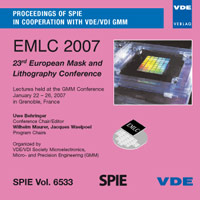Innovative Application of the RCWA Method for the Ultra-Sensitive Transmittance-Based CD Measurements on Phase-Shift Masks
Conference: EMLC 2007 - 23rd European Mask and Lithography Conference
01/22/2007 - 01/26/2007 at Grenoble, France
Proceedings: EMLC 2007
Pages: 9Language: englishTyp: PDF
Personal VDE Members are entitled to a 10% discount on this title
Authors:
Gray, Alexander (University of California at Davis, CA)
Lam, John C.; Chen, Stanley (n&k Technology, Inc., Santa Clara, CA)
Abstract:
A novel scatterometry method, based on broadband measurements of reflectance and transmittance spectra is presented. For the first time Rigorous Coupled Wave Analysis (RCWA) algorithm is applied to the analysis of the transmittance spectra for the determination of trench depths, critical dimensions, profiles, film thicknesses, and optical properties (n and k spectra from 190 – 1000 nm) of phase-shift photomasks. It is shown that very small structural and/or material variations, which are difficult to detect with reflectance (R) only measurements, can be readily distinguished with transmittance (T) measurements. For the current study, a spectrophotometer-based instrument (n&k R-T Scatterometer) was used, capable of collecting four continuous spectra during one measurement – two polarized reflectance spectra (Rs and Rp) and two polarized transmittance spectra (Ts and Tp). The light source of the spectrophotometer was equipped with a rotating polarizer, facilitating TE and TM polarizations of the measurement beam. The analysis was performed using Forouhi-Bloomer dispersion equations, in conjunctions with RCWA algorithm, applied simultaneously to reflectance and transmittance spectra. The method provided accurate and repeatable results of above stated parameters, for all materials present in the structure. A linearity study based on this novel reflectance-transmittance scatterometry method, demonstrated excellent correlation with the target values and the conventional CD-SEM measurements and improved repeatability compared to the traditional reflectance-only measurements. The advantages of the method are high throughput, non-destructive nature of the measurements, and capability to measure a wider variety of structures pertinent to the photomask manufacturing process.


